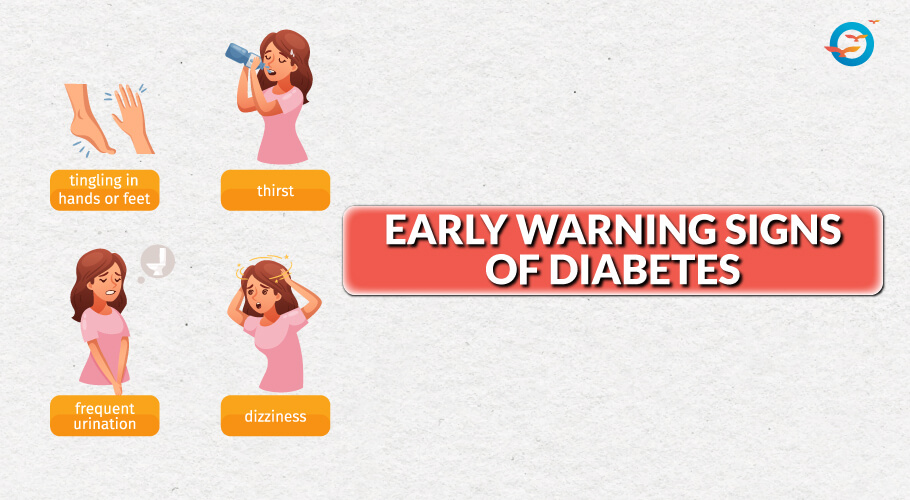Early Signs of Diabetes: What to Look Out For
While most illnesses and diseases come without signs, diabetes is not one of them. It does give out signs that you must recognise and treat...

Diabetes is one of the diseases and illnesses that does not have any symptoms. It does provide indicators that you need to identify and treat the illness as soon as possible. In India, one in five persons have diabetes, making it a relatively common condition. You most likely have it if you're between the ages of 40 and 60. If diabetes runs in your family, your chances are even higher.
Diabetes must be treated since it can lead to a number of problems, including heart attacks, strokes, and blindness. However, detecting signals comes before diagnosing, and diagnosis comes before treatment.
You will learn more about the warning signs of diabetes from this site.
What is Diabetes?
Diabetes occurs when the body cannot properly regulate blood sugar levels. In Type 1 diabetes, the immune system attacks insulin-producing cells in the pancreas, leading to little or no insulin production. Type 2 diabetes, the more common form, involves insulin resistance, where the body doesn’t use insulin effectively. Over time, the pancreas cannot keep up with the increased demand for insulin, leading to elevated blood sugar levels.
Early Signs of Diabetes
Recognising early signs of diabetes can lead to prompt diagnosis and treatment, which is essential for managing the condition. Here are some early indicators to watch out for:
1. Frequent Urination
One of the hallmark symptoms of diabetes is polyuria or frequent urination. High blood sugar levels force the kidneys to work overtime to filter and absorb the excess glucose. When they can’t keep up, the excess glucose is excreted into the urine, drawing water along with it. This process results in frequent urination, which can lead to dehydration and increased thirst.
2. Increased Thirst
Excessive thirst, or polydipsia, often accompanies frequent urination. As your body loses more water through urine, it triggers a feeling of extreme thirst to replenish lost fluids. Drinking more fluids may temporarily relieve the thirst, but if diabetes is the underlying cause, the problem will persist until blood sugar levels are controlled.
3. Unexplained Weight Loss
Sudden weight loss without a clear reason can be a red flag. In Type 1 diabetes, the body breaks down muscle and fat for energy because it can’t access glucose. This can result in noticeable weight loss even if your appetite hasn’t changed. In Type 2 diabetes, weight loss may occur if you’re losing fluids due to frequent urination.
4. Fatigue
Feeling unusually tired can be another sign of diabetes. When your cells are deprived of glucose, they lack the energy needed for normal function. This can lead to persistent fatigue and weakness. Additionally, the energy your body gets from food is often not used effectively due to insulin resistance.
5. Blurred Vision
High blood sugar levels can cause fluid to be pulled from tissues, including the lenses of your eyes. This can lead to blurred vision. Although this symptom may be temporary, it’s a good idea to have your vision checked and discuss these symptoms with a healthcare provider.
6. Slow-Healing Sores and Frequent Infections
Diabetes can impair the body’s ability to heal wounds and fight infections. High blood sugar levels can affect your immune system, reducing its efficiency. You might notice that cuts, bruises, or infections take longer to heal. Common infections in diabetics include yeast infections and skin infections.
7. Tingling or Numbness in Hands or Feet
Neuropathy, or nerve damage, is a complication of diabetes that can cause tingling, numbness, or pain in the extremities. High blood sugar levels can damage nerves over time, leading to symptoms like pins and needles sensations, especially in the hands and feet.
8. Dark Patches of Skin
A condition called acanthosis nigricans is sometimes associated with Type 2 diabetes. It causes dark, velvety patches of skin in body folds such as the neck, armpits, or groin. These changes in skin colour can be a sign of insulin resistance.
Concluding remarks
Early detection of the disease's symptoms can result in improved diabetes management and early intervention. It is important to pay attention to symptoms like increased thirst, frequent urination, weariness, impaired vision, slow-healing wounds, and skin abnormalities. For a comprehensive assessment, speak with a healthcare professional if you experience these symptoms.






















